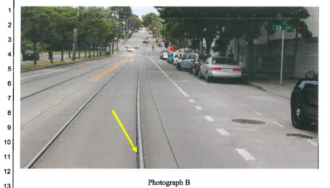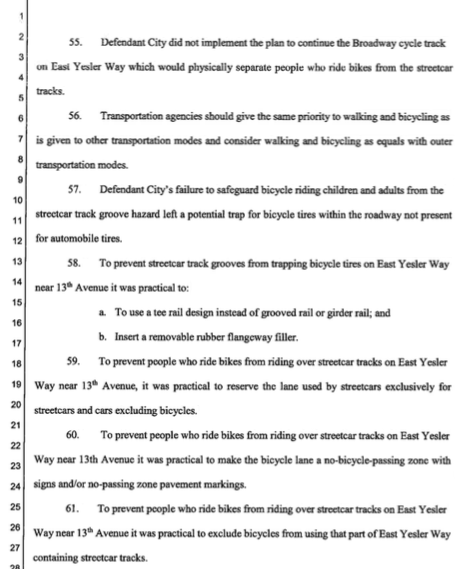
The family of Desiree McCloud has sued the City of Seattle for yet undetermined wrongful death damages following the 27-year-old woman’s fatal crash allegedly caused by the First Hill Streetcar tracks on Yesler Way near 14th Ave.
McCloud was biking with friends May 2016 when she crashed, passing away a week and a half later. After writing about her tragic death, Seattle Bike Blog was flooded with beautiful remembrances from people whose lives she had touched. Friends, family and neighbors held a memorial walk a month later in her honor.
Video eventually surfaced showing McCloud riding between the streetcar tracks just moments before she crashed. The lawsuit claims that she crashed trying to cross back over the track. Streetcar track gaps are just wide enough to grab or destabilize bike wheels.
A year after McCloud’s death, Jon Humbert and a Q13 News crew was filming a report at the spot where she crashed when Suzanne Greenberg crashed right in front of them in much the same way as McCloud. Greenberg spoke to Humbert before being transported to the hospital for some serious arm injuries. She has since joined the McCloud family in their lawsuit.
More details from Capitol Hill Seattle:
“The Defendant City knew there were other bicycle crashes occurring when bike tire were caught in streetcar rail grooves before DESIREE’s injuries and death and SUZANNE GREENBERG’s injuries,” the lawsuit filed just before Christmas reads.
Suzanne Greenberg was injured when she crashed her bike near the spot at 13th and Yesler where McCloud had fallen a year after the deadly incident.
McCloud, 27, died following her May 2016 crash that led to calls for safety improvements near Seattle’s streetcar tracks. The city’s investigation was unable to determine if the First Hill Streetcar tracks had caused the fatal crash.
Their joint lawsuit reads like a project list any street, bicycling, and pedestrian planner would be familiar with in Seattle.
Lawyers from the firm Campiche Arnold contend that the city neglected to include a laundry list of street safety measures in the area of the crash including the lack of a separated bikeway on Yesler:
Lynsi Burton at the Seattle PI has more, including comments by Greenberg about her crash and why she’s joining the lawsuit:
“It really goes against Seattle’s image,” Greenberg said. “I would think Seattle would be all about bicycle safety.”
And this wasn’t the only time Greenberg had fallen victim to the dangers of surface street train tracks. Four years earlier, she was trying to cross the South Lake Union Trolley tracks, but failed to cross them at a 90 degree angle and fell there, too.
In the wake of her more recent crash, Greenberg, a Vashon Island resident who commutes to Seattle, missed some work and was forced to sign with one hand while her other arm rested in a sling.
She’s back at work now and intends to return to bicycle commuting in the spring. Her commute hasn’t been as convenient in recent months, relying on public transportation, she says.
“I’ve missed the bike,” she said.










Comments
13 responses to “Family of Desiree McCloud files lawsuit over fatal streetcar track crash”
the TV story reads in part: “Their $2 million claim targets Seattle and Sound Transit, who partially funded the project. Sound Transit said they merely paid for portions of the project and Seattle operates the streetcar and tracks. The city couldn’t comment now that the claim has been filed.” The ST argument seems weak. The ST Board used a weak study to select the mode for the mitigation for the deleted First Hill Link station. Mode is the main issue.
You always sue everyone who could even be slightly liable. If you don’t, the people you do sue will find some way of blaming them.
Streetcars in Seattle are less flexible than trolleys, require expensive infrastructure and injure/kill cyclists – it confounds me as to why we have built any and that we are continuing to expand the system.
Love to hear any arguments in favor of streetcars over trolleys from anyone.
I just spent a week in Amsterdam. It has numerous street cars and every other person seems to be safely riding a bike. Streetcars and bicycles can interact safely if the system is well designed. Goodness knows why SDOT cannot invest a few $10K to send its employees to study a few European cities that have figured out how to do this.
I don’t think it’s a matter of knowing how to fix it, just a lack of will. Cycling is safer along some portions of the streetcar lines, but at this spot and others the investment in safer infrastructure wasn’t made. The investments need to be made along the entire alignment of the tracks. SDOT needs to respond quicker when problems become apparent
It isn’t that easy to fix it. Toronto has had numerous problems with their streetcar system and bike accidents, despite a much larger investment in streetcars (their streetcars aren’t expensive toys, like ours). That is because fixing it is very difficult. As this article details (https://www.treehugger.com/bikes/cyclists-and-streetcar-tracks-dont-mix.html) Amsterdam has largely fixed the problem, but did so in part because the city was built around streetcars. They managed to isolate bikes and streetcars. When they do mix, speed limits are very slow and bike paths ensure proper crossing angles (see the fourth picture).
The problem is, that is expensive. You would have to buy up a lot of land to enable a safer ride. Seattle prefers to stick its head in the sand, and pretend that our streetcars are big, and the problem doesn’t exist.
I’m not saying it’s going to be perfect but at this location SDOT hasn’t done anything more than what already existed before the streetcar. By simply removing parking the bike lane could be buffered or protected westbound. Parking could be removed east of 14th to create a bike lane where none exists today. The bus stop could be moved to the other side of the intersection. The bus could stop in lane with a bus island for bikes. The bus stop and streetcar stop could be combined on Yesler by moving the streetcar stop half a block. I’m saying that the same care in design that was employed to create the other sections of bike infrastructure along the first hill streetcar line was not implemented here or at a few other locations
+1
Trolley buses: routes are not permanently embedded in concrete, don’t need special signals, don’t get stuck when somebody blocks the track (the new buses apparently can even operate off batteries temporarily to get around blockages), easier to store at night, and most importantly don’t change the street into a deadly hazard for cyclists.
The only downside to trolleys is that they don’t carry as many people per vehicle. However, given the relative cost of the vehicles and how often the streetcars are actually full (is it ever?), this can be solved by running buses more often.
Hopefully this lawsuit turns class action and can stop further streetcar expansion.
If anybody wants to see truly horrible street car tracks, check out Commerce St/Pacific Ave in Tacoma.
>> The only downside to trolleys is that they don’t carry as many people per vehicle
That is true of some trolleys — or rather, of some streetcars. The problem is, our streetcars don’t have any more capacity than our buses.
@Rick — There are trade-offs with every mode, but unfortunately, they don’t apply to *our* streetcars. In other words, there is no reasonable case to be made supporting the use of *our* streetcars: https://seattletransitblog.com/2017/10/19/replace-ccc-better-bus-service/
The most bike friendly cities in the world have streetcars and bicycles. Its just the people who ride bikes in those cities actually know how to ride a bike and arent spandex warriors trying to ride as fast as humanly possible because they have convinced themselves that bikes are invincible while doing stupid things to save 3 seconds like ride on rails.
Since nobody mentioned it yet there’s a clear advantage when it comes to streetcars: they keep the road clean. If a car is ilegally parking on their way they will honk the horn and even have the car towed instead of driving around it, therefore potentially changing the behavior of inconsiderate drivers. Still, if the city is going to use them they’d better make sure they aren’t a thread to bikers.
I ride adjacent to these tracks at this intersection many times a week. I have ridden downhill toward it and uphill away from it. I go a little slower, use my brakes, and I’m fine.
This is a tragic, horrible accident, and I hope it doesn’t happen again. But unfortunately, I believe it was operator error. She should have slowed, and should not have routed her bike between the rails.
I think the demonization of rails on the road is overwrought. Among all the other hazards I face on my bike – rails on the road do not even rank in the top ten.
Inattentive drivers, double-parkers in bike lanes, pedestrians veering out into protected bike lanes, poor pavement conditions, poor access to safe routes, and many others are far, far, far more hazardous to me than rails on a handful of streets in the city. I do not believe this is a cause worth fighting with all the texting drivers, unfinished infrastructure, poor maintenance, etc. out there.